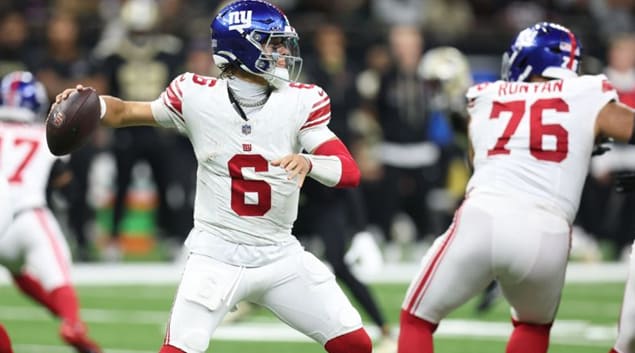With Friday's testing concluded we now have athletic profiles for most of this year's most important running back prospects. This article will assess the biggest winners and losers while adjusting projections for what round they might go off the board in the 2019 draft. Stop by tomorrow (Saturday) for the WR/TE recap.
The biggest winner was probably Oklahoma State early entrant Justice Hill (5-foot-10, 198 pounds), who added nearly 30 pounds to his frame over the last three years after arriving to the Cowboys at just 171 pounds. He added that weight while maintaining top-grade athletic metrics, including a 4.40-second 40-yard dash that led all combine running backs. He demonstrated his top-notch explosiveness further with a 40-inch vertical jump and 130-inch broad jump. In a class lacking explosiveness at running back, Hill's athletic profile really stands out. His prospect profile is limited by truly awful pass-catching production – 49 catches for 304 yards and one touchdown on 68 targets (72 percent catch rate, 4.5 YPT) is legitimately concerning – but I think you have to defer to the athleticism for the most part. It's also worth noting that as a true freshman Hill started over Chris Carson, who of course has proven his fit at the NFL level. His objective prospect comparisons are probably the likes of Ronnie Hillman and LaMichael James, though there are reasons to believe Hill is capable of a better career. I would have projected Hill as a 3rd-to-6th round pick before the combine, but I'd project him at 2nd-to-3rd now. He may have passed Darrell Henderson on some boards or even closed in on Josh Jacobs (who did not run) and Damien Harris. For my personal grades he remains more of a fourth-round prospect.
The biggest loser was probably Elijah Holyfield, who put up one of the worst combine showings of distant memory for a running back, especially among former top recruits. He checked in at 5-foot-10, 217 pounds but ran just a 4.78-second 40-yard dash while posting a similarly rough 29.5-inch vertical jump. Holyfield skipped agility drills, but if his film is any indication he likely would have had memorably bad results there as well. I thought Holyfield looked like a potential fourth or fifth-round pick before the Combine, but he'll almost certainly go undrafted now unless he lowers his 40 time to at least 4.65 at his pro day. It reminds me of the case of James Wilder Jr. at Florida State, who arrived as a high-ranking recruit and produced well for the Seminoles, but promptly disappeared after running a 4.86 40 at the combine.
In an otherwise descending order of projected draft slot, I'll run through the stock fluctuations of some other notable runners:
Damien Harris, Alabama (5-foot-10, 216 pounds)
STOCK STEADY
Harris' 4.57-second 40-yard dash was a tad disappointing after he was previously timed at 4.51 seconds in Alabama spring practices, but it's a totally adequate time given the sturdy build. He also helped himself a bit by logging a 37-inch vertical jump and 121-inch broad jump, both of which are above average. This is otherwise a guy who ran for 3,070 yards (6.4 YPC) in four years at Alabama, so the production variable gave him some margin of error in the athletic testing. His objective prospect indicators might not jump off the page, but you'd struggle to establish a meaningful difference between Harris' traits and someone like Sony Michel. Harris might not be worth a first-round pick, but I'd be shocked if he fell out of the second.
Darrell Henderson, Memphis (5-foot-8, 208 pounds)
STOCK STEADY
Henderson might have lost a tiny bit of speed raising his weight from around 200 to 208, but his testing Friday was still decent enough. You'd prefer he run a 4.40-second 40 or better, but the 4.49 he logged should be enough to lock him into the third round. If he had run a 4.40 or better then he would have been an easily justified top-40 pick. Henderson's college production remains compelling – I don't think you can average 8.9 yards per carry over 344 attempts unless you're actually fast.
Dexter Williams, Notre Dame (5-foot-11, 212 pounds)
STOCK UP
As a former standout recruit with a strong final collegiate season, Williams always held some intrigue in a running back class this thin, but he definitely helped himself further with his combine showing. His 4.57-second 40 doesn't stand out but is more than adequate once you account for the composite athleticism; his marks in all of the vertical (36 inches), broad jump (130 inches), three-cone (7.0 seconds), and 20-yard shuttle (4.16 seconds) were quite good, and he otherwise ran for 6.9 yards per carry over his final 197 attempts. I don't know who I'd compare him to but I'm becoming increasingly convinced that Williams is a real threat to go off the board on Day 2. He's one of the very few backs in this class with standout explosiveness with a starter-like frame.
Miles Sanders, Penn State (5-foot-11, 211 pounds)
STOCK UP
In terms of pure athletic talent, Sanders might be the most gifted running back in the draft. He'll face reasonable ball security scrutiny after fumbling 10 times at Penn State, but his athletic profile implies clear upside. He finished Friday with a 4.49-second 40-yard dash, 36-inch vertical, 124-inch broad jump, and 11.08 agility score. At this point I'd be shocked if he fell out of the fifth round and could envision him going off the board as early as the third.
David Montgomery, Iowa State (5-foot-10, 222 pounds)
STOCK STEADY
Montgomery didn't wow anyone with his 4.63-second 40-yard dash and his 28.5-inch vertical was quite bad, but if you were a fan of his before the combine then there's no reason to knock him on this basis. The optimist's theory with Montgomery was always that his balance and tackle-breaking ability drive his success to the point that his athletic limitations otherwise are rendered insignificant. I'm not sold on this optimist's theory, but Montgomery checked the boxes within the frame of that theory. To be clear, there is nothing disqualifying about the numbers he logged Friday. I suspect he's a case where plenty of teams don't really care about him, but the people who do like Montgomery seem infatuated with him. In a thin running back class, Montgomery has a shot to go on Day 2.
Travis Homer, Miami (FL) (5-foot-10, 201 pounds)
STOCK UP
Homer could easily go the way of a Daniel Lasco or some other vaguely-impressive, definitely-athletic running back prospect, but his Friday showing at the combine was legitimately strong in a way that could put him on the mainstream map for the first time. He's definitely light for his frame, but the combined figures of a 4.48-second 40, 39.5-inch vertical, and 130-inch broad jump imply real NFL-level explosiveness. Although never a workhorse, Homer was consistently a standout producer at Miami, running for 1,995 yards (6.0 YPC) and 12 touchdowns in three years. Homer evidently doesn't turn 21 until August, so it would be understandable if a team chased his upside on Day 2.
Alex Barnes, Kansas State (6-feet, 226 pounds)
STOCK UP
If not Hill, then Barnes is arguably your biggest combine winner at running back. Even as a big back Barnes was much more explosive than his fellow runners at Kansas State, so you can't call him a product of the system when engaging his production (2,616 yards and 25 touchdowns at 5.7 YPC). Barnes is unproven as a pass catcher and may be significantly limited in that regard, but as a pure runner he's a horse. Even as one of the biggest runners at the combine Barnes demonstrated good speed for his size (4.59-second 40) while adding excellent marks for explosiveness (38.5-inch vertical, 126-inch broad jump) and quickness (11.05 agility score). He might have been a better fit for the game 15 years ago, but someone now could easily justify a pick for Barnes in the fourth round.
Mike Weber, Ohio State (5-foot-10, 211 pounds)
STOCK STEADY
Weber was a rotational back at Ohio State and, while his production was always very good, it would have been nice to see him test a little better than he did Friday. You'd prefer an off-the-bench, passing-down back to possess safety-splitting speed, but Weber's 4.47-second 40-yard dash falls a bit short of that. Weber's production (2,676 yards, 24 touchdowns at 5.9 YPC) is his main selling point by now. It's hard to see him going before the fourth round but similarly difficult to imagine him falling past the sixth.
Ryquell Armstead, Temple (5-foot-11, 220 pounds)
STOCK UP
Armstead turned a few heads at the Senior Bowl and followed it up with a strong combine showing, putting him on the map as one of the more explosive Day 3 prospects at running back. He never really broke out or performed consistently at Temple, but injuries had something to do with that. A 4.45-second 40-yard dash at 220 will pique your interest, though, and Armstead's long speed checks out on tape. As a high-motor runner with surprising speed but a concerning injury history, a good comparison for Armstead might be Chris Ivory. I'd guess he's looking at the fifth or sixth round.
Trayveon Williams, Texas A&M (5-foot-8, 206 pounds)
STOCK DOWN
Williams' rushing production at Texas A&M is compelling – he ran for 3,615 yards (6.0 YPC) and 34 touchdowns – but his pass-catching production disappointed (561 yards in three years) and he showed very lopsided workout metrics Friday. His 4.51-second 40-yard dash was okay, especially when you factor in his hot-motor mentality, but his agility drills were dreadful, finishing with an agility score of 11.88. He seems quick enough on tape, but those numbers are bad enough to make you question what you think you saw. Williams' character grades highly and he figures to win over some coaches and scouts on that basis, but I'd be surprised if Williams goes earlier than the mid-fifth round.
Benny Snell, Kentucky (5-foot-10, 224 pounds)
STOCK STEADY
Snell's workout was pleasantly surprising in some aspects and predictably unimpressive in others. Some might try to argue his day was either good or bad, but as someone who considered him a late Day 3 prospect all along I'd say he sooner helped himself than hurt himself, though I still think he falls well short of a starting projection in the NFL.
First, the good: Snell ran the three-cone drill in 7.07 seconds, which is legitimately decent for a runner at his weight. His 4.66-second 40-yard dash was not standout, but adequate for his weight and is better than I was expecting. It's the same time that Jeremy Hill ran, for instance.
The bad news is his vertical jump of 29.5 inches was not good, and speaks to his general lack of explosiveness. My comparison is BenJarvus Green-Ellis and I'm sticking with it, though the previously mentioned Hill is probably fair for the most part. I suppose Snell could go off the board in the third or fourth round, but I'd sooner guess the fifth or sixth.
Devin Singletary, Florida Atlantic (5-foot-7, 203 pounds)
STOCK DOWN
If the biggest loser isn't Holyfield, then it's Singletary. His weight is more than adequate for his frame, but Singletary's compelling college production is undermined by the poor athletic testing from Friday, where he timed at 4.66 seconds in the 40-yard dash and then an even worse agility score of 11.72. I think this is one of those cases where you can convince yourself to overlook the numbers somewhat, especially because Singletary is nothing if not agile when you turn on the tape, but even if this is merely a matter of not training properly Singletary objectively grades far below average as a composite athlete. Whether he can overcome that with innate skill is an unsettled question, but the odds are not in his objective favor at this point. He probably compares most fairly to fellow past hyper-productive, under-athletic small backs like Jahad Thomas, Javon Ringer, and Akrum Wadley. After previously projecting Singletary as a 3rd-through-5th sort of prospect, I'd guess the fifth round is his best-case scenario now.






















